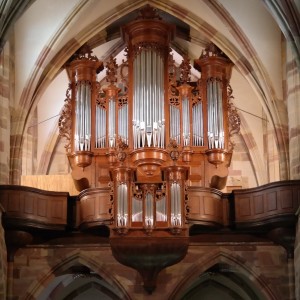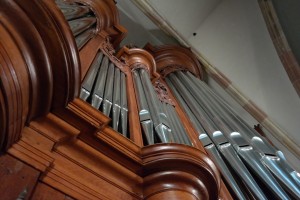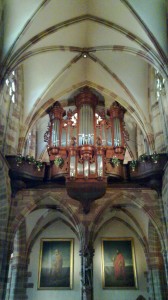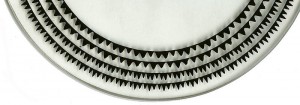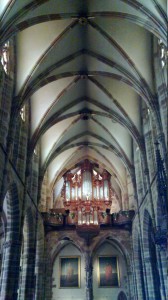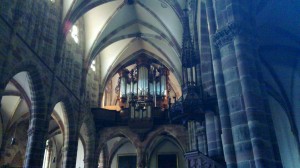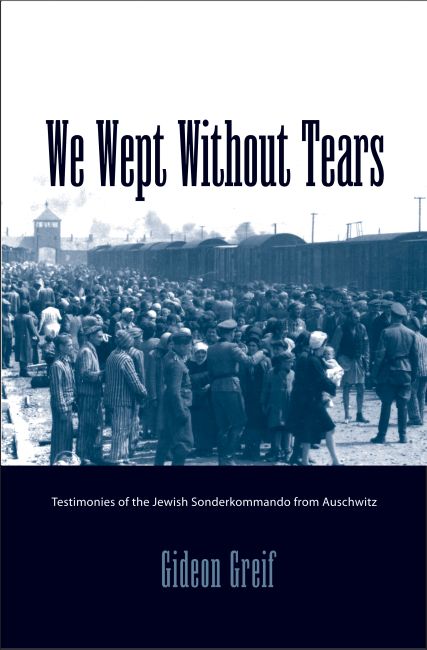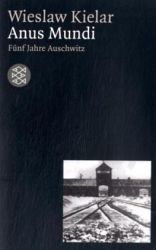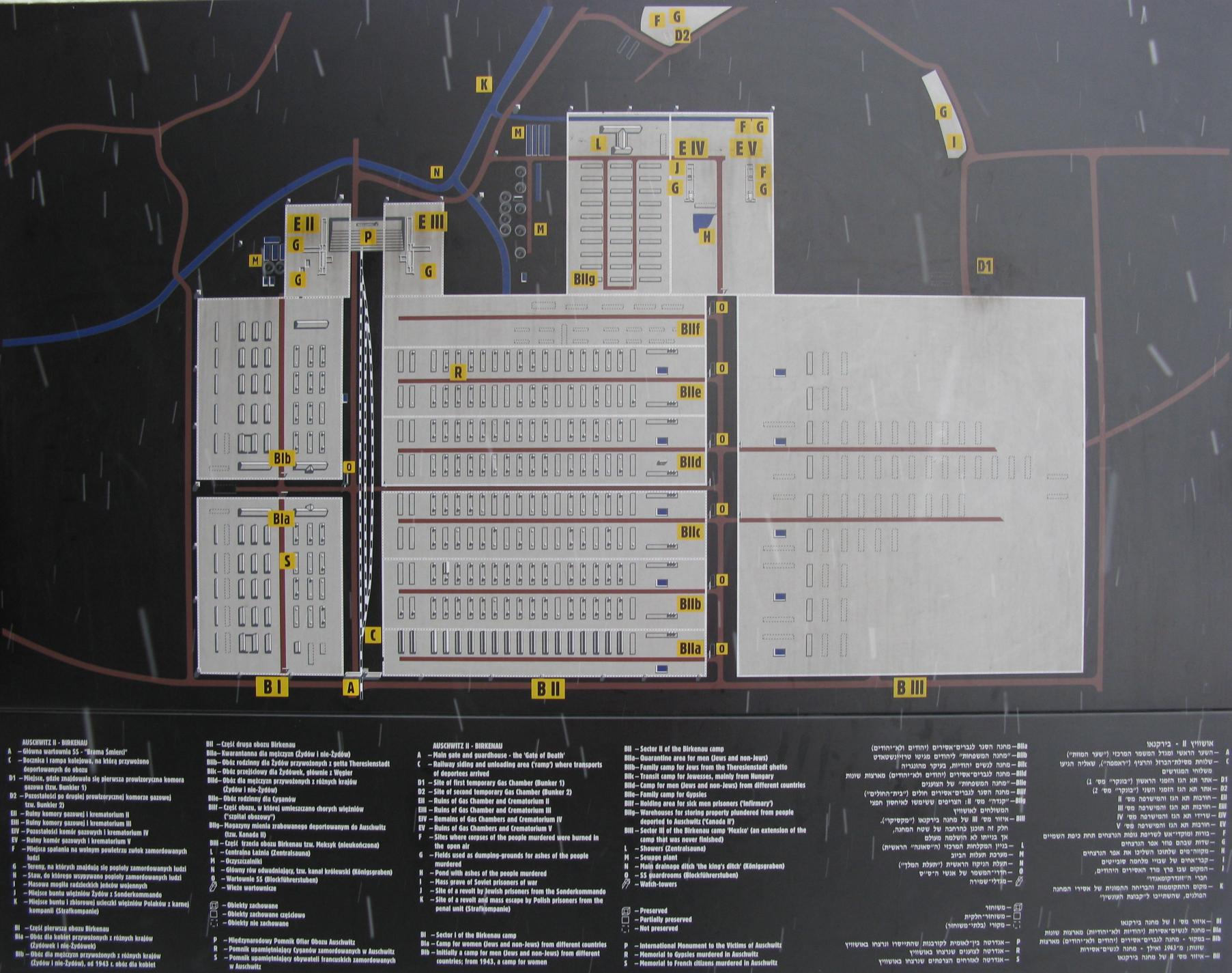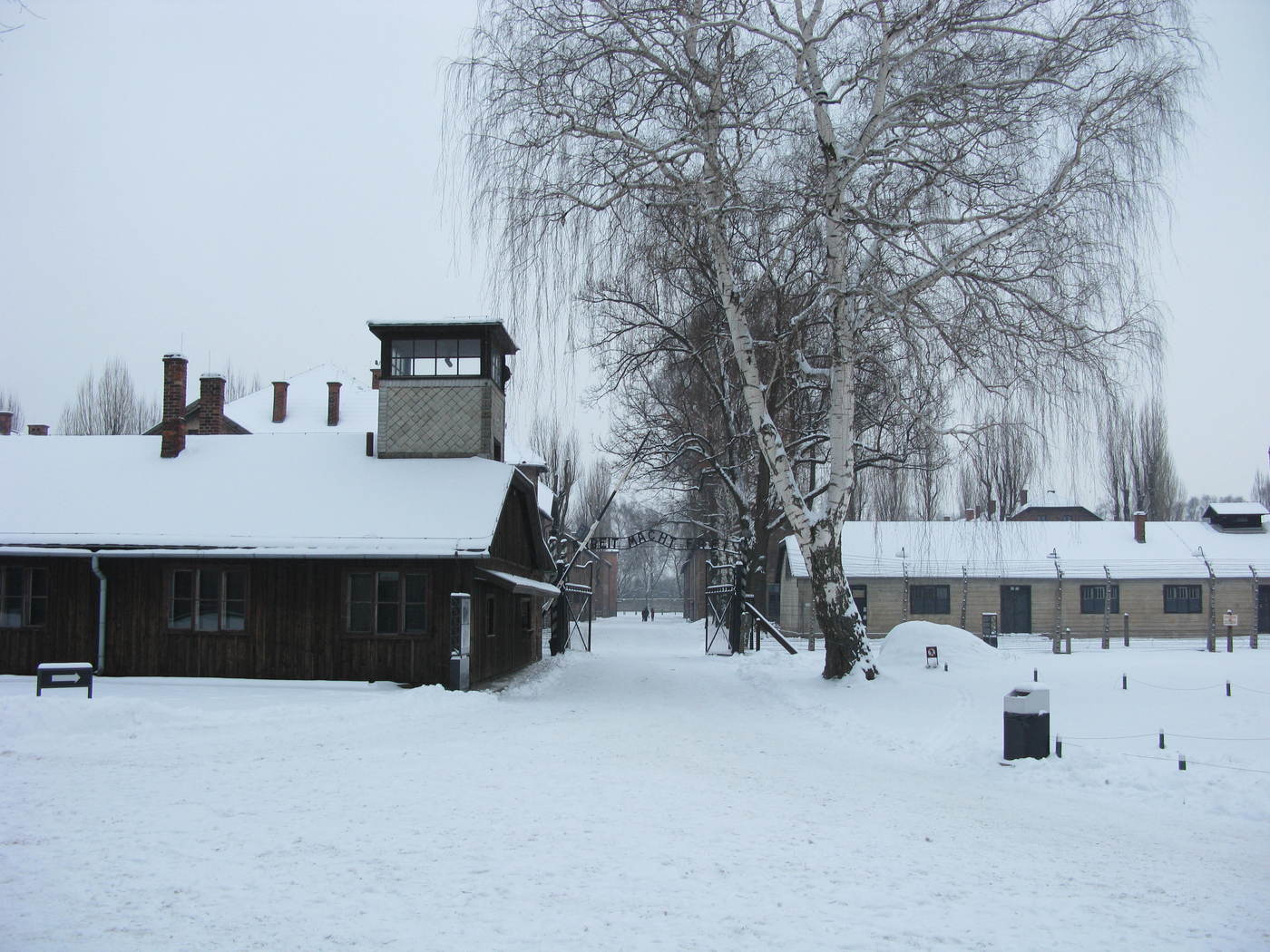Today the program of this year’s vespers was published. And again I’ll travel to Wissembourg each sunday to listen to the outstanding sound of the Dubois organ. Thanks to all involved in the organisation of the events.
Category Archives: History
Kleines Konzert auf der historischen Dubois-Orgel in Weißenburg
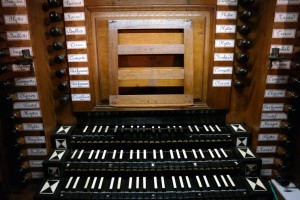
Ich bin außerordentlich dankbar dafür, dass ich hin und wieder auf dem wertvollen Instrument in Sts Pierre et Paul in Wissembourg spielen darf. Man sagt den deutschen Instrumenten den „Silber-“ und den französischen den „Goldklang“ nach. Das Cornet, das Plein Jeu (Prinzipalplenum) mit der tiefliegenden Fourniture (Mixtur), die Zungenstimmen wie Cromorne (Krummhorn) und nicht zuletzt das Grand Jeu klingen deulich anders als deutsche Instrumente. Zudem ist das Instrument im Vergleich zu jüngeren Vertretern drei Halbtöne tiefer und ungleich schwebend gestimmt.
Im Mai letzten Jahres hatte ich einige Stücke für meine Familie gespielt. Heute Mittag hatte ich erneut die Gelegenheit dazu. Hier die Auswahl:
- Abraham van den Kerckhoven (1618 – 1702) – Preludium & Fuga sowie Fantasia in d
- Johann Pachelbel (1653-1706) – Chaconne in f-Moll
Beim Üben im April sind die Stücke recht gut gelaufen. Leider nicht so letzten Sonntag. Gestern lief es besser, aber noch immer nicht so, als dass ich mich für heute Mittag gut vorbereitet fühlte. Allerdings ist es immer wieder so, dass es dann doch klappt, sobald es darauf ankommt. Dass ich in der Hektik des Spiels ein paarmal die Tasten nicht ganz sauber getroffen oder die Fingersätze nicht im wünschenswerten Maße berücksichtigt habe gehört wohl mit dazu. Erstaunlich gut bin ich mit dem verhältnismäßig kleinen Pedal zurechtgekommen.
Das Erarbeiten der Stücke hat mir im vergangenen dreiviertel Jahr sehr viel Freude, aber auch viel Arbeit bereitet. Daher werde ich jetzt erstmal eine kleine Pause einlegen. Ich vermute allerdings, sie wird nicht allzulange dauern.
Vor 100 Jahren – die erste Jassplatte wird aufgenommen
So zumindest sieht es Stefan Hentz in der Zeit.
Besichtigung der Dubois-Orgel in Wissembourg
Am Samstag hatten wir die Gelegenheit, die Dubois-Orgel in Wissembourg aus der Nähe zu betrachten, während die Organistin die ein oder andere spannende Geschichte über die Restaurierung zu erzählen wusste.
First anniversary of the Inauguration of the Dubois organ
Almost one year passed since the inauguration of the Dubois organ at the abbey of Peter and Paul in Wissembourg. To celebrate the anniversary a nice concert took place yesterday from 8 PM to 10 PM.
Pascal Reber and Markus Eichenlaub played pieces of various composers. Three have been played using four hands by both artists. A screen has been used so that the audience could see the artists and their helpers working at the console.
I especially enjoyed the »Chaconne en fa mineur« of Johann Pachelbel, one of my favorites which I haven’t heard for ages.
Just like last year the instrument can be heard during the vespers each sunday at 5 PM (August 11 at 4 PM) between June 9 and September 15.
I’d like to thank all who helped to make this happen, especially the many volunteers.
The very first ROMpler…
Though the Lichttonorgel was not a commercial success, it was the very first sample player ever. It was invented and developed by Edwin Welte, a member of the famous company known for their orchestrions and reproducing pianos. The latter instruments can be seen in action in several museums in the south-west of germany.
BTW: The piano roll they invented still can be found as an editor in many software sequencers to create and manipulate control events.
The Lichttonorgel can be seen as one of the predecessors of the Optigan and Orchestron, a competitor of the Mellotron. New sound disks for the Optigan are still available via optigan.com, including sound samples.
Les vesperales de l’orgue Dubois en Wissembourg
After its inauguration, the Dubois organ is used for a series of vespers during this summer, happening each sunday afternoon from 5 PM to 5:50 PM. Though the inauguration just happened one week ago, Daniel Maurer yesterday was in desperate need of tuning the lingual pipes of the backside positiv 15 minutes before the concert. He played the following pieces:
- J.S. Bach
- Choral »Komm, Gott Schöpfer, heiliger Geist« (BWV 667)
- F. Couperin
- Récit de Cornet
- Cromorne sur la taille
- J.S. Bach
- Fantaisie en sol majeur (Très vitement, Gravement, Lentement) (BWV 572)
- Choral »Meine Seele erhebet den Herrn« (BWV 243)
- F. Couperin
- Offertoire sur les grands jeux
- Récit de Tierce en Taille
- G.F. Haendel, Suite N°1 for a musical clock
- A voluntary or a flight of angels (HWV 600)
- Menuet (HWV 603)
- Gigue (HWV 589)
Today Pascal Reber played the following:
- Claude Gervaise, Danceries de la Renaissance
- Pavane
- Gaillarde
- Branle de Champagne
- Branle de Bourgogne
- J.S. Bach
- Choral »Herr Jesu Christ dich zu uns wend« (BWV 655)
- Choral »Komm heiliger Geist, Herre Gott« (BWV 652)
- Louis Nicolas Clérambault
- Plein Jeu
- Duo
- Trio
- Basse de cromorne
- Flûtes
- Récit de nazard
- Caprice sur les Grands Jeux
- Pacal Reber
- Improvisation I
- Improvisation II
I especially enjoyed the first block of ancient renaissance pieces. During the second improvisation, he played rather unconventional stuff, showing that the instrument is not only capable of reproducing classical music.
Two excellent concerts which I really enjoyed.
L’Orgue Dubois de l’abbatiale Sts. Pierre et Paul en Wissembourg
Today I had good luck, as some organ player played the Dubois organ at the Peter and Paul abbey in Wissembourg.
Auschwitz-Birkenau Panorama
Here’s a panorama picture I took in Auschwitz-Birkenau. It’s far from being perfect, as I only used the automatisms of Hugin without further interaction or editing. The camera position was approximately here, with camera movement from east over south to west (left to right):
I took the images in auto mode, thus the variant exposures. I should have used the stitch assistant instead.
Eye-witness accounts of Sonderkommando survivors
The second book I just read about the mass extermination of jews during the second world war is called »We wept without tears« (»Wir weinten tränenlos…«) by Gideon Greif. It’s a compilation of various interviews he held with some survivors of the Sonderkommando of the extermination camp Auschwitz-Birkenau.
Anus Mundi
If you remember a little latin, you might know what »Anus Mundi« means (a vulgar german translation would read as »Arsch der Welt«). Still under the impression of my recent visit to O?wi?cim, Poland, I wanted to get a bit of a clue what life was like in those infamous german concentration camps.
Concentration Camp Auschwitz-Birkenau (Auschwitz II)
The Birkenau extermination camp (aka Auschwitz II) was built a couple of months later than Auschwitz I. Both are sited in the delta between the rivers So?a and Wis?a. The area is completely flat. An information board provides details about the camp’s site (sorry for the snow flakes). The planned area on the right hand side was never completed, due to the end of the second world war:
Concentration Camp Auschwitz I
On the first day of my stay in O?wi?cim, I visited the concentration camp Auschwitz I. Though it is wee small compared to the later built mass termination camp in Auschwitz-Birkenau, the main camp remained the administrative center of all Auschwitz camps for the five years the Auschwitz camps existed.
To get into the camp just cross the main entrance building. After a few meters, there’s the zynical »Arbeit macht frei« (»labour liberates«) gate to the camp’s entrance on the right hand side:

